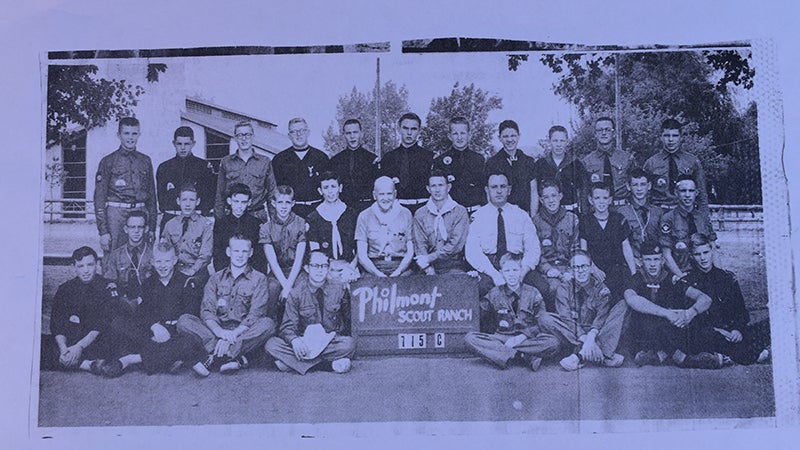A scout’s memories of Philmont
Published 10:05 am Friday, March 29, 2024
|
Getting your Trinity Audio player ready...
|
WEST POINT — In a recent meeting of the West Point Rotary Club, long-time member Edmund Glover talked about a trip he and fellow Boy Scouts and Explorer Scouts took to the Philmont Rocky Mountain Scout Camp in 1956.
Camp Philmont was fairly new at the time. It’s today the world’s largest youth camp. Located in New Mexico, the camp consists of 140,000 acres. That’s 220 square miles, an area big enough to have more than 300 miles of trails, 35 staffed backcountry camps and 770 campsites.
Then and now, a trip to Philmont is any Boy Scout’s dream.
“I was 18 at the time and had just graduated from high school,” Glover told members of the club. “Mr. Grady Bradshaw, who was head of the local Scout council at the time, told me that a local group of Scouts would be making a trip to Philmont that summer. He asked me if I’d like to go with him as a junior assistant.”
He was stunned by that opportunity and could hardly get out the words, “I’d love to!”
Young Edmund was with Explorer Post 3 in West Point at the time. He would make the trip that summer with Bradshaw, his assistant Howard Bright and Scouts from West Point and the Valley area. They rode by bus, driven by a Mr. Jolley. There was no Interstate highway system at the time, and the trip by road would take a good bit longer back than what it does today, but that made for more stops along the way and some interesting experiences today’s travelers wouldn’t have.
One of Glover’s chores was to keep track of each Scout’s money. Each boy took $30 with them and needed to be careful how they spent it.
They also took traveler’s checks. The problem was a number of places they’d stop at were cash only.
They made it to Keesler Air Force Base in Biloxi, Mississippi, on the first day and spent the night there. They made it to Houston, Texas, the next day and spent the night at another Air Force base that would later become the Johnson Space Center, NASA’s base of operations for human space flight. The bus made Del Rio, Texas, the next day. This gave most of the group a chance to travel outside the U.S. for the first time. They spent some time across the border in Ciudad Acuna, Mexico.
“The banks were closed that day, and we couldn’t cash a traveler’s check,” Glover said. “We went to some local businesses to see if we could cash it and they said no. We were finally able to get it cashed at a taxi stand. Each boy got $2 to spend in Mexico. We walked up and down the streets of that Mexican city for a couple of hours. There were lots of bars and souvenir shops. When we got back to the bus, customs agents asked us if we had bought anything in Mexico. One of us had gotten a whip that had a dagger hidden in it.”
The agent discovered the dagger when looking over the whip. The Scout told him he had no idea it was there.
“The customs agent told him to be very careful in handling the whip and let him keep it,” Glover said.
From then on, the Scouts would be very careful in spending their money on the rest of the trip.
Philmont is a paradise for a Boy Scout. There’s lots of hiking and horseback riding.
“Every night we would be at a different camp,” Glover said. “We learned how to climb telephone poles wearing shoes with spikes. You had to be very careful in how you did it.”
The local Scouts spent two nights in Ritito Canyon.
“I went with a group that climbed a mountain,” Glover said. “It was easier going up than it was coming back down. Each time we went out we carried with us enough food to last each one of us for three days.”
That’s all a part of a Scout following the motto of Being Prepared.
One hike took them to a peak that was over 10,000 feet in elevation. “It was hard to breathe at that altitude,” Glover said. “We had dried food with us. It was usually vegetables and rice, and we had to boil it in water before we could eat it.”
Back at a base camp below the mountain, the Scouts were told to be careful with where you put your food. Bears were known to forage the area looking for anything to eat.
“The boy that was staying with me in my tent wanted to see a bear,” Glover said. “He put a candy bar on a stick and hung it outside our tent. The bears did come that night but not for the candy bar. I was so glad they passed it by.”
Near the end of the camping excursions, one of the boys got really sick.
“We had to take him to the infirmary,” Glover said. “We were really concerned about him but he was okay the next day. We were really relieved.”
The boy was named Julian and was 14 years old at the time. He would go on to become a highly respected medical doctor, helping many others get over their illnesses. West Point native Dr. Julian Duttera served for more than four decades as an oncologist and hematologist in LaGrange. For over 30 years he was the medical director of the Enoch Callaway Cancer Center.
He died in 2019 following a 13-year battle with Parkinson’s disease. In memory of what he did for the health and well-being of his fellow man, the Callaway Foundation has a conference center named in his memory.
“Dr. Duttera demonstrated his love for our community through his lifesaving work with cancer patients,” reads a testimonial of the center’s opening. “(He was) a champion for rural health care access, and by helping to develop West Georgia Hospice. His legacy of compassion lives on in this new home for local cancer care.”
Another boy on that trip, Drew Ferguson, grew up to be a bank president in his hometown. His son would serve as a council member and mayor in West Point before becoming a U.S. Congressman.
At the end of their outdoor adventure, Jolley drove the Scouts back home through the Texas Panhandle and Arkansas. “We went through Hot Springs and stayed in a hotel there,” Glover said. “I was able to shave and take a hot shower. It was the first time I had taken a real bath in a number of days. It was so good to be clean again.”
Glover went back to Philmont in 2006. It marked the 50th anniversary of the trip he made in 1956. “Six of us made that trip,” he said. “It was two people in each of three Suburbans. My wife Sandra was with me. It was a whole lot easier riding all over the camp in a Suburban compared to having hiked to those places when we were young. The camp was a lot more developed than it was when we were there in 1956.”
In 1922, wealthy Tulsa oilman Waite Phillips purchased what is now the Philmont Scout Ranch. He made it his summer home and called it Villa Philmonte. He completed it in 1927 and some eleven years later donated the 220-square-mile site to the Boy Scouts of America and designated it as a training center.
The camp is a very active place today. Some 22,000 Scouts and their leaders are expected to go on 12-day visits this summer. Every day, 350 Scouts will arrive as 350 are leaving, Another 3,500 will be hiking the backcountry at the same time.





